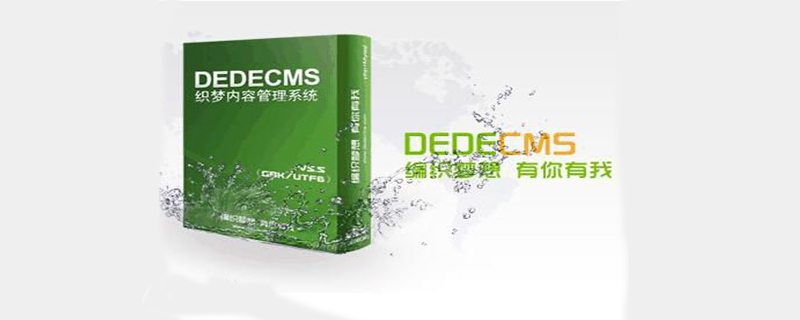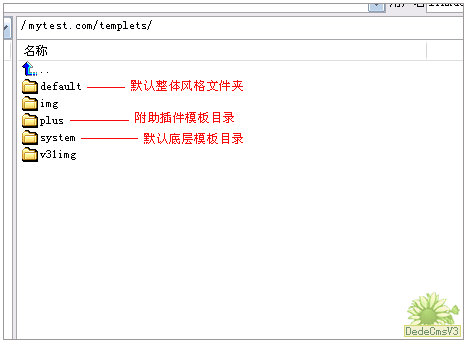How to use dedecms system
How to use the dedecms system after it is installed? The first thing to note is that some concepts of dedeCms may be different from some CMS, especially some small news systems. The principles of the two are different, so you must understand some special concepts of DedeCms.

1. Channel model and website columns
[1] Channel model: refers to articles, software downloads, photo albums, Different types of content models such as FLASH sets, different channel models, corresponding to different templates and publishing and editing forms.
[2] Column management: The model of DedeCms is kernel-based, which may be different from some modular CMS. Each channel of a modular CMS is an independent subsystem with specialized classification and Other management, but all content columns of DedeCms are managed uniformly. If you want to create a new download category, you do not need to go to another module, but directly create a new column in the column management, and select "Software" as the content type. Download".
[3] When using DedeCms for the first time, please pay attention to some common options for creating columns:

a. Whether to support submission: This option is only for atlases , articles and custom models are valid. Member submissions are not supported by default. Therefore, you must open a column for submission before members can contribute in the background.
b. Sorting order: This is used to sort the columns. The smaller the value, the earlier the columns are sorted.
c. Column attributes: including three options: final list column, channel cover, and separate page. The default is the final list column, which means that this column directly generates the article list; channel cover is a special column, usually It means that this column itself does not contain any content, but there are many subordinate columns, such as: http://dedecms.com/web-art/index.html This page is a typical channel cover, which can be used more flexible method to expand the content of lower-level columns; a separate page, generally used for company profile, about us and other pages.
d. Column list option: Under normal circumstances, the columns are connected to index.html. If you find it troublesome to manually generate HTML every time, you can select the column "Use dynamic page" here, so When browsing columns, it is a dynamic program that updates in real time, rather than an HTML page that needs to be manually generated.
2. Document publishing
Concept - Document:
In the usual news system, it is called article or news, but because CMS except articles , also includes software, atlases, or content of your own custom type, so they are collectively called documents.
If you want to publish new documents in Dedecms, you must create a new column of this channel type in "Website Column Management", and the published documents can only be in the "Final List Column". Columns with other attributes are Documents cannot be published.
3. HTML update
By default, DedeCMS will generate HTML for published documents. If you have not changed the website template or collected it back content, no need to manually update the document HTML. In addition, the background can also choose whether to update the HTML of the homepage when publishing the document. If yes is selected, there is no need to update it every time. However, the column list needs to be updated manually, that is, every time you update the content of your website, you need to update the corresponding column HTML in the "HTML Update->Update Column HTML" area, so that users can browse your content. (If the column "Use Dynamic Pages" is used, you don't need to pay attention).
4. Template replacement
The main template structure of DedeCms is as shown below:

Generally speaking , if the website has no special requirements, the auxiliary plug-in template and the default underlying template will not move. If you downloaded the template from another website, you can create a new directory here (try to use an English name, because some systems do not support Chinese Directory), and then change the default style name default to the directory name of the new template you use in the background "System Settings->Modify System Parameters". In addition, the default file cannot be deleted without special reasons. Yes, because online templates generally do not include all channel types.
The above is the detailed content of How to use dedecms system. For more information, please follow other related articles on the PHP Chinese website!

Hot AI Tools

Undresser.AI Undress
AI-powered app for creating realistic nude photos

AI Clothes Remover
Online AI tool for removing clothes from photos.

Undress AI Tool
Undress images for free

Clothoff.io
AI clothes remover

AI Hentai Generator
Generate AI Hentai for free.

Hot Article

Hot Tools

Notepad++7.3.1
Easy-to-use and free code editor

SublimeText3 Chinese version
Chinese version, very easy to use

Zend Studio 13.0.1
Powerful PHP integrated development environment

Dreamweaver CS6
Visual web development tools

SublimeText3 Mac version
God-level code editing software (SublimeText3)

Hot Topics
 1377
1377
 52
52
 Where is the imperial cms resource network template?
Apr 17, 2024 am 10:00 AM
Where is the imperial cms resource network template?
Apr 17, 2024 am 10:00 AM
Empire CMS template download location: Official template download: https://www.phome.net/template/ Third-party template website: https://www.dedecms.com/diy/https://www.0978.com.cn /https://www.jiaocheng.com/Installation method: Download template Unzip template Upload template Select template
 How dedecms implements template replacement
Apr 16, 2024 pm 12:12 PM
How dedecms implements template replacement
Apr 16, 2024 pm 12:12 PM
Template replacement can be implemented in Dedecms through the following steps: modify the global.cfg file and set the required language pack. Modify the taglib.inc.php hook file and add support for language suffix template files. Create a new template file with a language suffix and modify the required content. Clear Dedecms cache.
 What website can dedecms do?
Apr 16, 2024 pm 12:24 PM
What website can dedecms do?
Apr 16, 2024 pm 12:24 PM
Dedecms is an open source CMS that can be used to create various types of websites, including: news websites, blogs, e-commerce websites, forums and community websites, educational websites, portals, other types of websites (such as corporate websites, personal websites, photo album websites, video sharing website)
 How to upload local videos to dedecms
Apr 16, 2024 pm 12:39 PM
How to upload local videos to dedecms
Apr 16, 2024 pm 12:39 PM
How to upload local videos using Dedecms? Prepare the video file in a format that is supported by Dedecms. Log in to the Dedecms management backend and create a new video category. Upload video files on the video management page, fill in the relevant information and select the video category. To embed a video while editing an article, enter the file name of the uploaded video and adjust its dimensions.
 How to use dedecms
Apr 16, 2024 pm 12:15 PM
How to use dedecms
Apr 16, 2024 pm 12:15 PM
Dedecms is an open source Chinese CMS system that provides content management, template system and security protection. The specific usage includes the following steps: 1. Install Dedecms. 2. Configure the database. 3. Log in to the management interface. 4. Create content. 5. Set up the template. 6. Manage users. 7. Maintain the system.
 Accurate and reliable dedecms conversion tool evaluation report
Mar 12, 2024 pm 07:03 PM
Accurate and reliable dedecms conversion tool evaluation report
Mar 12, 2024 pm 07:03 PM
Accurate and reliable dedecms conversion tool evaluation report With the rapid development of the Internet era, website construction has become one of the necessary tools for many companies and individuals. In website construction, using a content management system (CMS) can manage website content and functions more conveniently and efficiently. Among them, dedecms, as a well-known CMS system, is widely used in various website construction projects. However, sometimes we are faced with the need to convert the dedecms website to other formats, in which case we need to use a conversion tool
 A simple way to learn dedecms encoding conversion function
Mar 14, 2024 pm 02:09 PM
A simple way to learn dedecms encoding conversion function
Mar 14, 2024 pm 02:09 PM
Learning dedecms encoding conversion function is not complicated. Simple code examples can help you quickly master this skill. In dedecms, the encoding conversion function is usually used to deal with problems such as Chinese garbled characters and special characters to ensure the normal operation of the system and the accuracy of data. The following will introduce in detail how to use the encoding conversion function of dedecms, allowing you to easily cope with various encoding-related needs. 1.UTF-8 to GBK In dedecms, if you need to convert UTF-8 encoded string to G
 What loopholes does dedecms have?
Aug 03, 2023 pm 03:56 PM
What loopholes does dedecms have?
Aug 03, 2023 pm 03:56 PM
DedeCMS is an open source content management system that has some potential vulnerabilities and security risks: 1. SQL injection vulnerability. Attackers can perform unauthorized operations or obtain sensitive data by constructing malicious SQL query statements; 2. File Upload vulnerability, attackers can upload files containing malicious code to the server to execute arbitrary code or obtain server permissions; 3. Sensitive information leakage; 4. Unauthenticated vulnerability exploitation.




